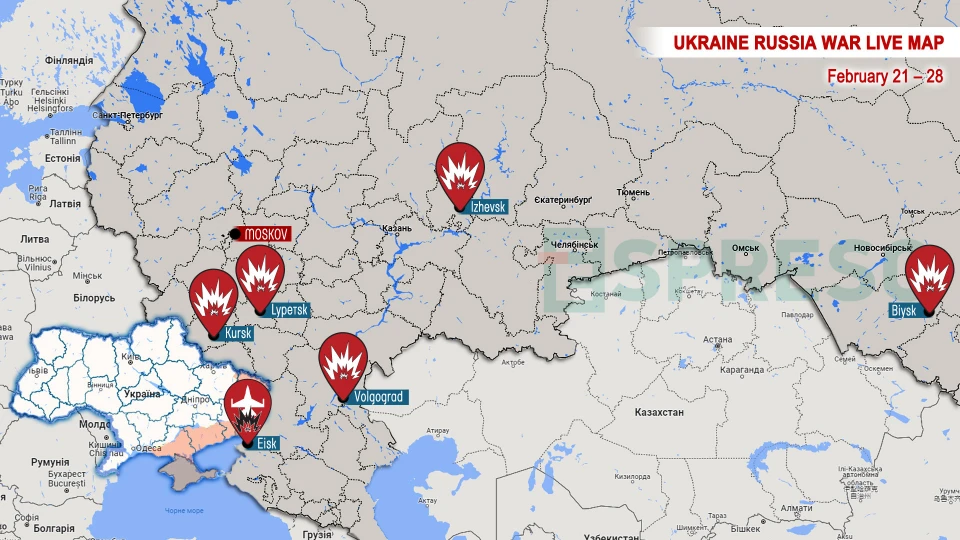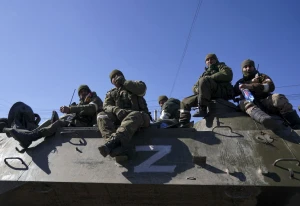
February 21-28 live war map: Avdiivka occupation consequences and struggle for air supremacy
The situation remains critical for the Ukrainian Armed Forces on the eastern front, particularly near Chasiv Yar, Novomykhailivka, and villages to the west of Avdiivka
Avdiivka front is changing rapidly
After the occupation of Avdiivka, the front line to the west of the city has become unstable, and combat operations have spread outwards by 10 kilometers. On one hand, the Russian forces are attempting to leverage their numerical superiority and advance as far as possible. To achieve this, they have introduced new forces to this sector. On the other hand, it is also dangerous for the Ukrainian Armed Forces to remain close to Avdiivka, which is situated on dominant heights, providing clear firing lines to the nearby villages of Stepove, Lastochkyne, and Sievierne. Over the course of the week, Ukrainian defensive forces have withdrawn to the west, to more advantageous positions where they are less exposed. Currently, this buffer zone measures 3 to 5.5 kilometers, with a temporary stabilization line established along the villages of Berdychi, Orlivka, and Tonenke. However, it is uncertain whether the situation will remain stable for an extended period. Invading Russian forces are already conducting assault operations on the outskirts of Berdychi and Orlivka.
Despite significant losses in aviation, Russian armed forces continue to bombard Ukrainian positions with cluster munitions. While previously around 50 cluster bombs fell on Ukrainian defenders' heads per day, this number has nearly doubled now. Even the use of air defense systems does not deter the Russians. The enemy understands that a window of opportunity has opened for them, which may never come again.
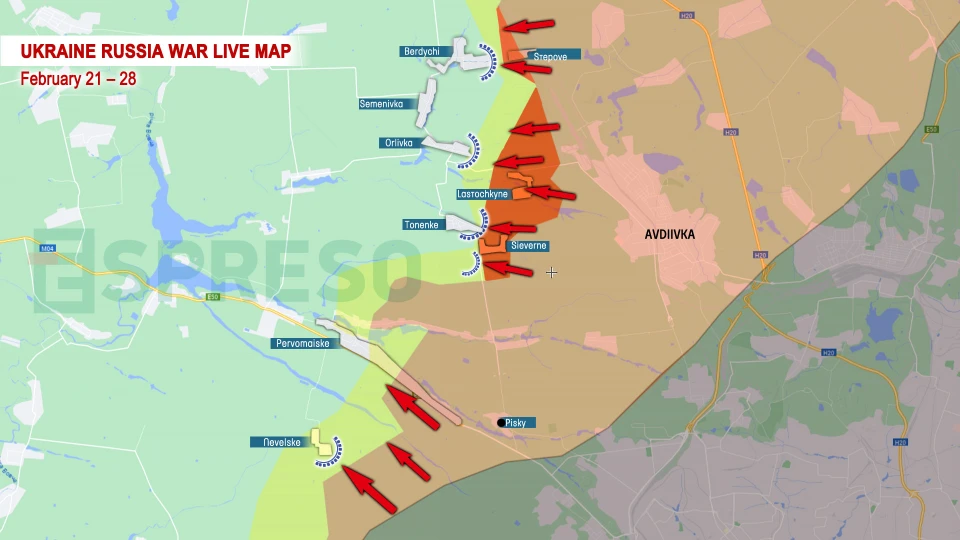
Bahmut front: battles for Chasiv Yar and Kostiantynivka shelling
Another consequence arising from the loss of Avdiivka is the heightened pressure exerted by the Russian troops on adjacent sections of the front, particularly along the Bakhmut front. The situation on the approaches to Chasiv Yar has significantly deteriorated as a result. The Russian forces have reached the eastern outskirts of the village of Ivanivske and are striving to advance further. Beyond this village lies a direct road to Chasiv Yar. However, Ivanivske now serves as a significant obstacle hindering any mechanized Russian assaults. A similar scenario has unfolded further north, in Bohdanivka, where battles have been raging on the northern outskirts of the village for over a month. The occupation of Bohdanivka would enable the invaders to advance close to the northern outskirts of Chasiv Yar. Additionally, the Russians are attempting to bypass Klishchiivka from both the north and south to complicate ammunition logistics.
It is evident that the largest urban agglomeration after Donetsk – Sloviansk, Kramatorsk, and Kostiantynivka – is a priority target for the aggressor state. Therefore, Russian troops are already laying the groundwork for their future offensive. To achieve this, they need to depopulate the current center of Donetsk region. This explains the shelling of Kostiantynivka, during which the enemy destroyed the railway station, 14 buildings, 3 educational institutions, and several administrative buildings.
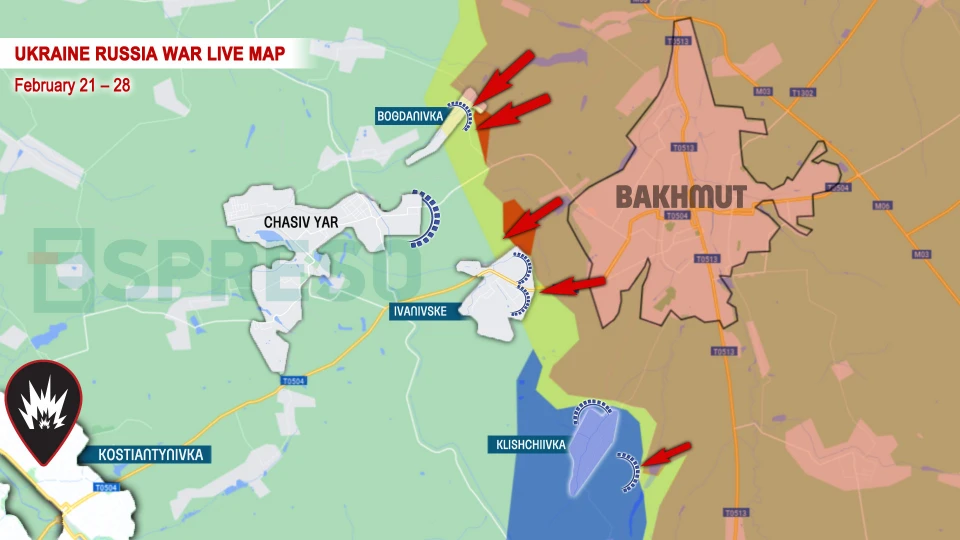
Vuhledar front map near Novomykhailivka
This week, the Ukrainian Defense Forces managed to completely deter the Russian troops’ offensive on Novomykhailivka despite being attacked from three sides. Additionally, the Ukrainian Armed Forces also thwarted attempts by Russian forces to break through from Marinka to the south through the village of Pobieda and to flank Ukrainian troops. For several days, the Russian aggressors fully occupied Pobieda, but the Ukrainian Armed Forces launched a counteroffensive and partially drove them out of the village.
Moving slightly southward, particularly near Dokuchaievsk and further south of Volnovakha, in the village of Trudivske, for two consecutive days, Ukrainian forces decimated about one and a half hundred Russians with precise HIMARS strikes, whom reckless commanders had deployed for inspection. A similar situation repeated itself in the Kherson region a few days later.
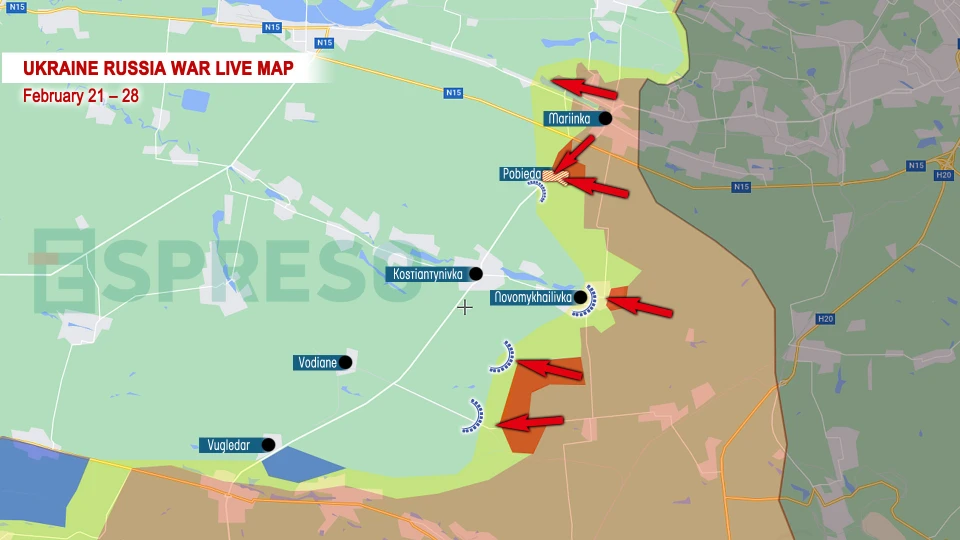
Robotyne hell in Zaporizhzhia region: weekly updates
Russians are attacking the village and the entire Robotyne ledge every day from the western flank, as well as from the south and southeast. They have assembled a sufficiently powerful force for this purpose. For instance, just recently, four columns of armored vehicles attempted to break into the village from the right flank, but most of the vehicles were destroyed by the Ukrainian Defense Forces: 18 out of 30 armored vehicles during a single assault. Although the Russians have claimed several times about the reoccupation of Robotyne, the Ukrainian defenders firmly hold positions in the center of the village, although they have withdrawn from several positions on its outskirts.
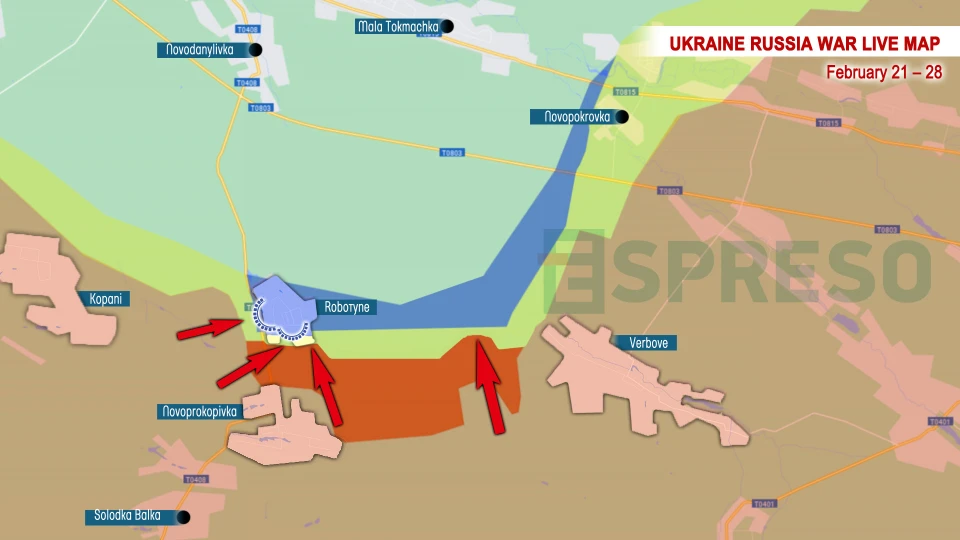
Aerial combat over Ukraine is shifting the focus
Ukraine is preparing to receive F-16 aircraft while simultaneously attempting to deter Su-34 bombers, which are carriers of guided bombs, from bombing Ukrainian positions. In the past ten days, Ukrainian air defense systems have shot down seven Su-34 bombers and two of the latest Su-35 fighter jets, which pose a significant threat to the F-16.
Another serious threat comes from the combination of the long-range radar detection and control aircraft A-50 with the S-300 air defense systems. It is likely that for these reasons, the Armed Forces of Ukraine, together with allies, have begun a real hunt for this aircraft. While the first shooting down of an A-50 in January was a unique historical event, the second incident near Yeysk in the Krasnodar Krai on the symbolic day of February 23rd left the Russians in a state of shock. The event occurred 220 km from the front line, and the Ukrainian shot was made from an even greater distance. Now, Ukraine only needs to target another aircraft to poke a hole in the round-the-clock reconnaissance activity of the Russians, which covers at least the entire eastern part of Ukraine east of the Dnipro River. Already, the intensity of A-50 operations has significantly decreased, with several days passing without any sightings.
A new stage of the war has begun in the sky, aimed at pushing Russian aircraft out of the airspace of Ukraine, including the occupied territories.
Map of Russia's war on Ukraine: a gas station leaks
Within a short period of time, military factories and oil industry facilities have been ablaze in Russia. In Lipetsk, a part of the Novolipetsk Metallurgical Plant exploded. In Izhevsk, which is a center for arms production, a major fire broke out in a building manufacturing UAVs. Powerful explosions caused a fire at a defense plant specializing in chemical technologies in the city of Biysk, located in the Altai region.
No less significant were the explosions at one of Russia's largest oil refineries in Volgograd, as well as the fire at an oil depot in the Kursk region. The consequence of systemic strikes on Russia's oil industry was that the country, labeled as a terrorist state, banned gasoline exports for six months to redirect it for military needs. Indeed, the export of oil and petroleum products is the primary source of currency through which Putin purchases weapons worldwide.
The maps were created based on information obtained from the General Staff of the Armed Forces of Ukraine, as well as from other open and verified sources. However, the maps are not maximally accurate and only conditionally reflect trends in the combat zone.
- News






